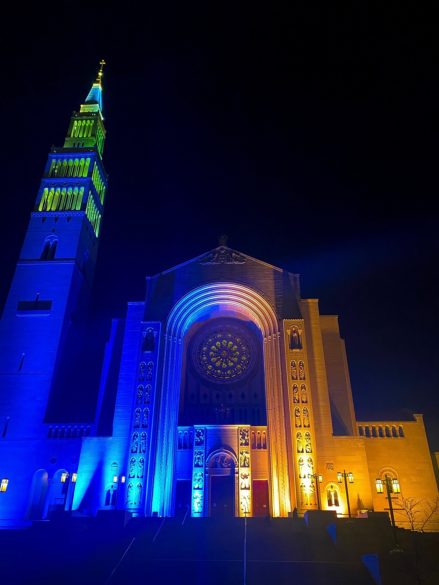
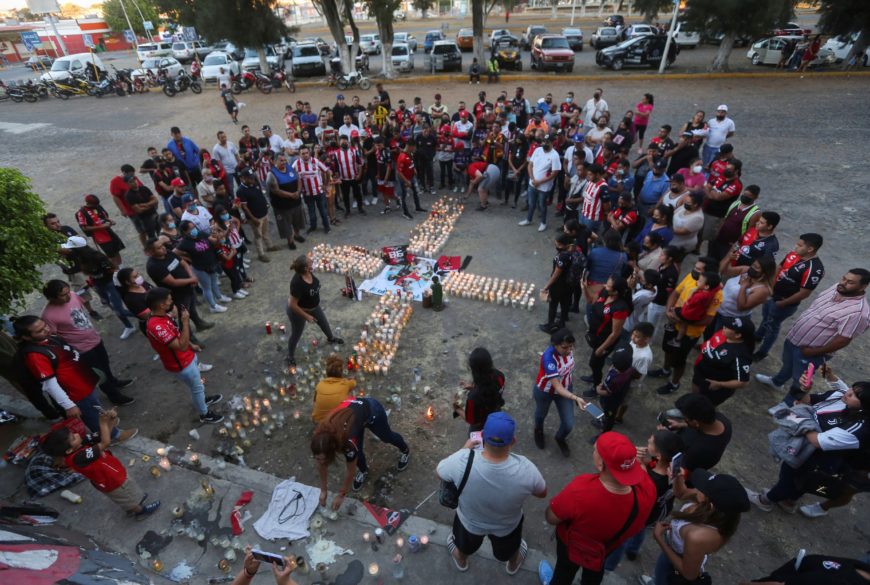
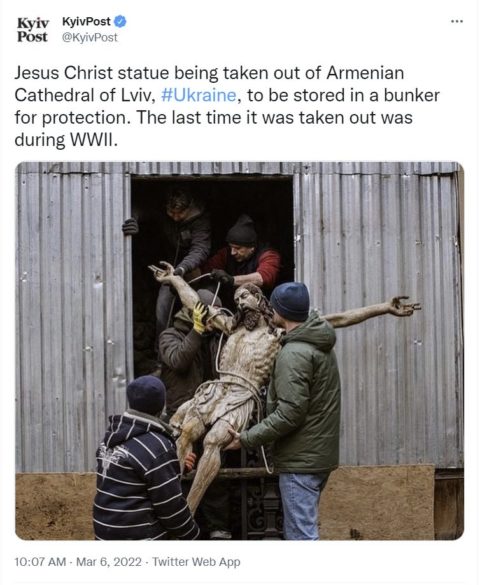
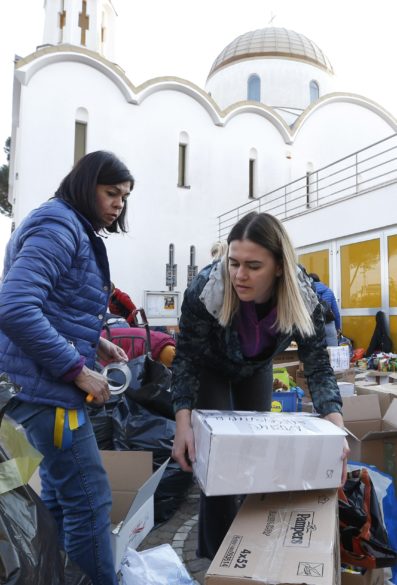

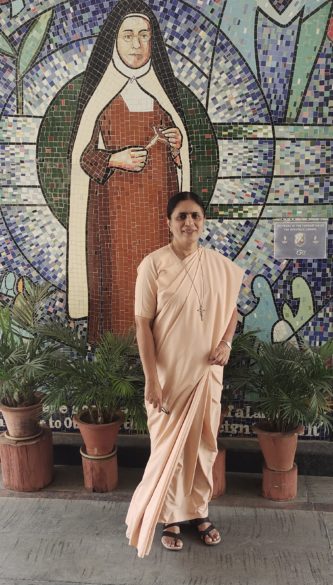






NATION
CINCINNATI (CNS) – The Los Angeles Rams may have won Super Bowl LVI over the Cincinnati Bengals, but students in Catholic schools in both archdioceses are winners as well. Donors contributed more than $22,000 – and counting as of Feb. 17 – for tuition assistance scholarships as part of a friendly wager between Archbishop José H. Gomez of Los Angeles and Archbishop Dennis M. Schnurr of Cincinnati over the game’s outcome. The donations to each archdiocese’s Catholic Education Foundation came as the archbishops invited supporters to become involved in their good-gesture wager through the Bishops Big Game challenge. In the Feb. 13 game, the Rams were behind in the third quarter and most of the fourth quarter, before scoring the winning touchdown with 1:25 left, beating the Bengals 23-20. With the Rams’ victory, the Los Angeles foundation will receive 60% of the funds raised, while the Cincinnati foundation will received 40% of the money donated.
NASHVILLE, Tenn. (CNS) – From partaking in the sacrament of reconciliation to fasting to choosing what to give up, Lent is full of traditions that Catholics around the world take part in as they prepare to celebrate Christ’s passion, death and resurrection. But there’s another sacred tradition that dates back to the early days of the Crusades; one that allows them to “walk” the Via Dolorosa with Christ: the Stations of the Cross. The Stations of the Cross are a mini-pilgrimage, taking believers through the steps taken by Jesus on Good Friday, from his condemnation to his burial. The stations are a “way of prayerfully uniting oneself to the sacrifice of the Lord and his love for us,” said Father Eric Fowlkes, pastor of the Cathedral of the Incarnation in Nashville. “It’s also an invitation for us to place ourselves within that journey.” The Stations of the Cross date back to the Middle Ages during the religious wars between Christians and Muslims, known as the Crusades. “The Crusades awakened an interest in Europe in the places associated with Christ in the Holy Land. For the first time, Europeans were traveling there regularly and wanted to see the holy places where the biblical events took place,” said Father Bede Price, pastor of Church of the Assumption in Nashville.
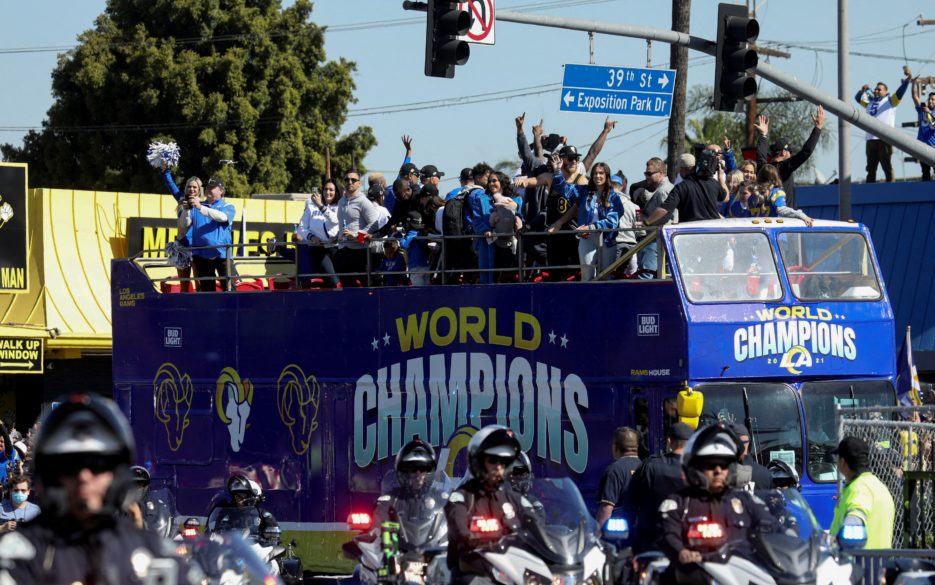
VATICAN
VATICAN CITY (CNS) – Pope Francis advanced the sainthood cause of Argentine Cardinal Eduardo Pironio, the prelate who organized and oversaw the first six international celebrations of World Youth Day. The pope also approved a decree recognizing a miracle attributed to the intercession of Capuchin Poor Clare Sister Maria Costanza Panas of the Italian monastery of Fabriano. She was born Jan. 5, 1896, and died May 28, 1963. In addition to recognizing the miracle that clears the way for her beatification, the pope approved decrees recognizing that four candidates for sainthood heroically lived the Christian virtues; the decrees were signed during an audience Feb. 18 with Cardinal Marcello Semeraro, prefect of the Congregation for Saints’ Causes. The four candidates, who are now “venerable,” included Cardinal Pironio, who had served in numerous offices in the Roman Curia from 1975 until his retirement in 1996. St. Paul VI called him to Rome as pro-prefect of the Vatican congregation for religious. When St. John Paul II named him to head the Pontifical Council for the Laity in 1984, the late pope instituted the annual celebration of World Youth Day, including huge international gatherings presided over by the pope every two years and organized by the laity council.
VATICAN CITY (CNS) – As part of ongoing measures to reform the Roman Curia, Pope Francis has approved restructuring the Congregation for the Doctrine of the Faith, the oldest of the congregations. Once comprised of a doctrinal office, a discipline office and a marriage office, the new structure will see the doctrinal and discipline offices become their own special sections led by their own secretaries; the marriage office will become part of the doctrinal office. The two secretaries will serve under the congregation’s prefect. Spanish Cardinal Luis Ladaria, who has been prefect of the congregation since 2017, will celebrate his 78th birthday April 19. The heads of Vatican offices are required to offer their resignations to the pope when they turn 75. In “Fidem servare” (Preserving the Faith), published “motu proprio,” (on his own initiative) Feb. 14, Pope Francis said the main task of the congregation has been to safeguard or “keep the faith.” The changes went into effect the same day. Over time, the congregation has seen modifications to its areas of responsibilities and how it is configured, and now, Pope Francis said, further change is needed “to give it an approach more suited to the fulfillment of its functions.”
WORLD
SÃO PAULO (CNS) – The Diocese of Petrópolis and the city’s parishes have opened their doors to assist victims of the torrential rainstorm that flooded the historic city of Petrópolis. Bishop Gregório Paixão Neto asked that priests and parishioners take in people whose houses were affected by the Feb. 15 mudslides and needed shelter. “This moment is one of solidarity, and we of the Catholic Church are deeply united and in solidarity with all families,” Bishop Paixão said in a video message released on social media. “I ask you to welcome your relatives, your friends and those who are in despair, looking for a place to stay. I, myself, already have a family staying in my house,” he added. The mid-February storm is considered one of the worst in city in the past 70 years, with rainfall surpassing 10 inches in six hours, a volume greater than expected for the entire month of February. As of early Feb. 17, 104 deaths had been recorded, and dozens were still missing under the mud and rubble. The Archdiocese of Rio de Janeiro, through Caritas, launched the SOS Petrópolis campaign, asking for donations for families affected by the rains.
IQUITOS, Peru (CNS) – Oil spills on opposite sides of Peru – one near Lima, the coastal capital, and the other in a remote Indigenous village in the Amazon – brought together Catholics in the two regions for simultaneous Masses Feb. 13. They prayed for those suffering from the pollution caused by both spills as they marked the second anniversary of “Querida Amazonia,” (Beloved Amazonia), the papal exhortation issued by Pope Francis after the 2019 Synod of Bishops for the Amazon. The liturgies, accompanied by video messages exchanged by Bishop Miguel Angel Cadenas of Iquitos and Archbishop Carlos Castillo Mattasoglio of Lima and played at each of the Masses, formed the first such joint initiative between bishops in Lima and the Amazon. In January, similar disasters struck the two regions. A ship offloading oil Jan. 15 at a coastal refinery spilled about 6,000 barrels of oil into the Pacific Ocean, fouling at least 30 miles of shoreline. On Jan. 20, vandals cut an oil pipeline in a small Amazonian village, contaminating the river that people depend on for water for drinking, cooking and bathing. In his homily, Archbishop Castillo said, “We have a commitment – our city of Lima and our entire coast – to our Amazon region.”
NATION
NEW YORK (CNS) – In emotional remarks Feb. 2 at St. Patrick’s Cathedral, the sister of slain Officer Wilbert Mora paid tribute to her brother and his late partner, Officer Jason Rivera, but also decried the “violence and crime” taking the lives of police as they try to protect the citizenry. “It hurts me to know that two exemplary young men, like Officer Jason Rivera and Wilbert Mora, were taken before their time,” Karina Mora told the mourners who packed the cathedral for the funeral Mass for her brother. The service took place less than a week after Rivera’s funeral Mass, also at the cathedral. These were two young men “who wanted to make a difference and a change in their city with their service and their sacrifice,” said Karina Mora, who spoke in Spanish, with her words interpreted in English for the congregation. “Now I only ask myself, how many Wilberts, how many Jasons, how many more officers will have to lose their lives for this system to change?” she said. “How many other lives who protect us will be taken away by violence and crime? How many mothers? How many more mothers, how many children will have to lose their family and live this trauma and this kind of tragedy?”
WASHINGTON (CNS) – Trying to advance the economic status of American Indians is like playing a game of Monopoly that they can never win, said panelists during a Jan. 30 plenary session of the Jan. 29-Feb. 1 Catholic Social Ministry Gathering. “Imagine you arrive to the game late … and you see what properties are remaining. On this monopolized board, all the properties are taken. That’s where we come in. We were invited to play the game decades later,” said Lakota Vogel, executive director of the Four Bands Community Fund in South Dakota. “We come to the Monopoly board without money to buy the property, and we can’t even build houses there. We just hope we build something that makes everybody else pay taxes,” said Tara Mason, historical trauma coordinator for the Niibi Center, a nonprofit organization serving the White Earth Reservation members in Minnesota. “We’re at a disadvantage from multiple perspectives,” added Mason, herself a member of the Minnesota Chippewa Tribe, White Earth Band. “It’s not even the same Monopoly game that we have an opportunity to play.” Vogel said one solution would be to “rewrite the rules of the game. Or maybe we’re creating a whole new board for us to operate in.” Pete Upton, board chair of the Native CDFI Network – CDFI is an acronym for community development financial institution – is trying to rewrite those rules. And if he can’t do it, he suggested that Congress can.

VATICAN
VATICAN CITY (CNS) – Akash Bashir, a 20-year-old volunteer security guard who was killed by a suicide bomber in 2015, is the first Pakistani to be given the title, “servant of God,” an initial step on the path to sainthood. Archbishop Sebastian Shaw of Lahore, Pakistan, informed Catholics of his archdiocese that Pope Francis had granted the title to Bashir Jan. 31, the feast of St. John Bosco. “We praise and thank God for this brave young man, who could have escaped or tried to save himself, but he remained steadfast in his faith and did not let the suicide bomber enter the church. He gave his life to save more than a thousand people present in the church for Sunday Mass,” the archbishop said, according to Fides, the news agency of the Congregation for the Evangelization of Peoples. Bashir had studied at the Don Bosco Technical Institute in Lahore and was one of the parishioners of the Church of St. John who volunteered to provide security outside the church. “Akash was on duty at the church entrance gate on March 15, 2015, when he spotted a man who wanted to enter the church with an explosive belt on his body,” Fides said. “Akash blocked him at the entrance gate, foiling the terrorist’s plan to massacre those inside the church.”
VATICAN CITY (CNS) – The “true gold medal” at the upcoming Olympic and Paralympic Games goes to everything that helps the global community be more welcoming and accepting of all people, Pope Francis said. At the end of his general audience Feb. 2, the pope focused on the bonds that unite all people in one human family as he prayed for the people of Myanmar, spoke about the upcoming 2022 Beijing Olympics and Paralympics and anticipated the International Day of Human Fraternity. For more than a year, “we have watched with pain the violence staining Myanmar with blood,” the pope said. A coup Feb. 1, 2021, ended the country’s experiment with democracy and set off protests and repression, death and detention. Joining an appeal launched by the country’s bishops, the pope called on the international community “to work for reconciliation between the parties involved. We cannot look away from the suffering of so many of our brothers and sisters. Let us ask God, in prayer, for consolation for that tormented population.” Pope Francis also noted that Feb. 4 would be the second celebration of International Day of Human Fraternity, a U.N.-declared observation to promote interreligious dialogue and friendship on the anniversary of the document on human fraternity signed in Abu Dhabi in 2019, by Pope Francis and Sheikh Ahmad el-Tayeb, grand imam of Al-Azhar in Egypt.
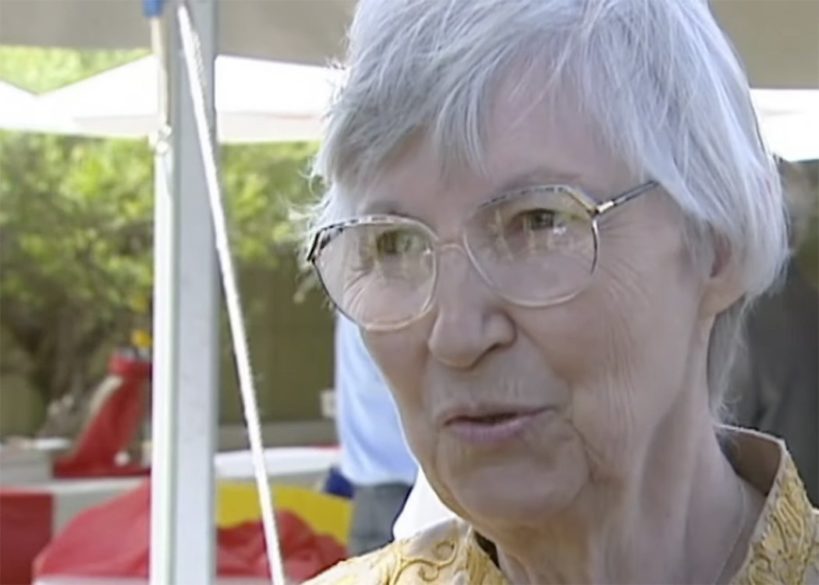
WORLD
MEXICO CITY (CNS) – Retired Bishop Onésimo Cepeda Silva of Ecatepec – the colorful and controversial Mexican bishop who rubbed shoulders with the rich, served one of the country’s roughest dioceses and made a brief, but disastrous foray into electoral politics – died Jan. 31. He was 84. The Diocese of Ecatepec confirmed Bishop Cepeda’s death, as did the Mexican bishops’ conference, which barely 10 months earlier disavowed his registration as a legislative candidate for a minor political party. Bishop Cepeda had contracted COVID-19 three weeks earlier, according to church statements. Mexican media reported he had been intubated. Bishop Cepeda cut a controversial course through Mexico’s public life. He served the ramshackle suburbs of Mexico City, but appeared in society publications and played golf at expensive country clubs. Politicians and business elites regularly attended his birthday celebration. He reputedly came under investigation for his acquiring a wealthy church donor’s art collection, which contained works by Latin masters Diego Rivera and Rufino Tamayo. Bishop Cepeda also served as a godfather to bullfighters, according to Mexican media.
ADELAIDE, Australia (CNS) – Mercy Sister Janet Mead, who earned gold records for her 1974 hit version of the Our Father, died Jan. 26 in her native Adelaide. She was 84 and had been battling cancer. In 1974, “The Lord’s Prayer,” set to an uptempo rock beat, scaled up the charts, peaking at No. 4 in the United States and No. 3 in Australia, earning her gold records for the single. Sister Mead was an unlikely pop star. The only other nun in U.S. history to crack the top 10 in the United States was Soeur Sourire, better known as The Singing Nun, for her lively folk ode to St. Dominic, 1963’s French-language “Dominique.” Sister Mead also was the first Australian to have a gold record in the United States. The single was distributed to 31 countries, according to ABC, Australia’s government-subsidized broadcaster, selling, by various accounts, 1.5 million, 2 million or 3 million copies worldwide. Sister Mead was even nominated for a Grammy, but lost out to Elvis Presley. She declined an offer to tour the United States and donated all her royalties to charity. But for those who weren’t monitoring Top 40 radio in 1974, they might have heard her arrangement played during Masses at Catholic churches and schools.
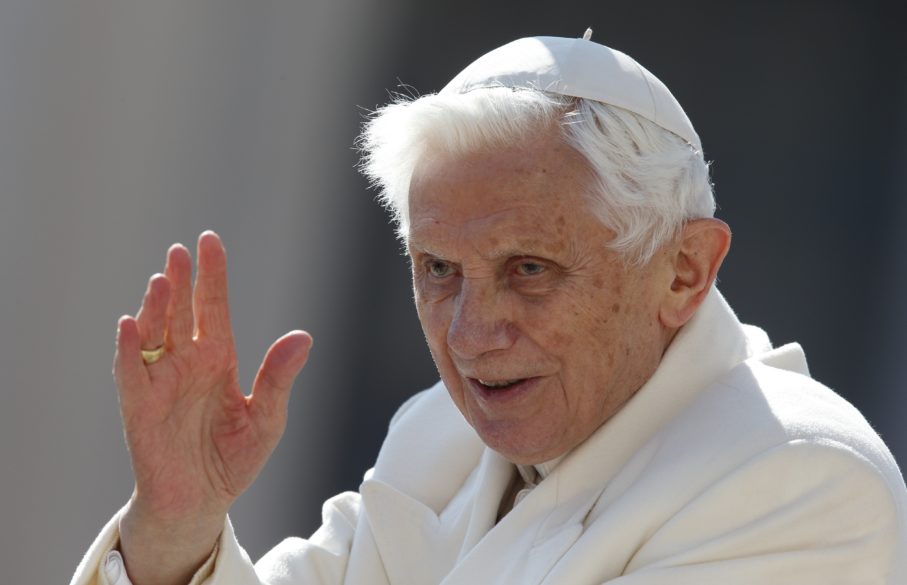
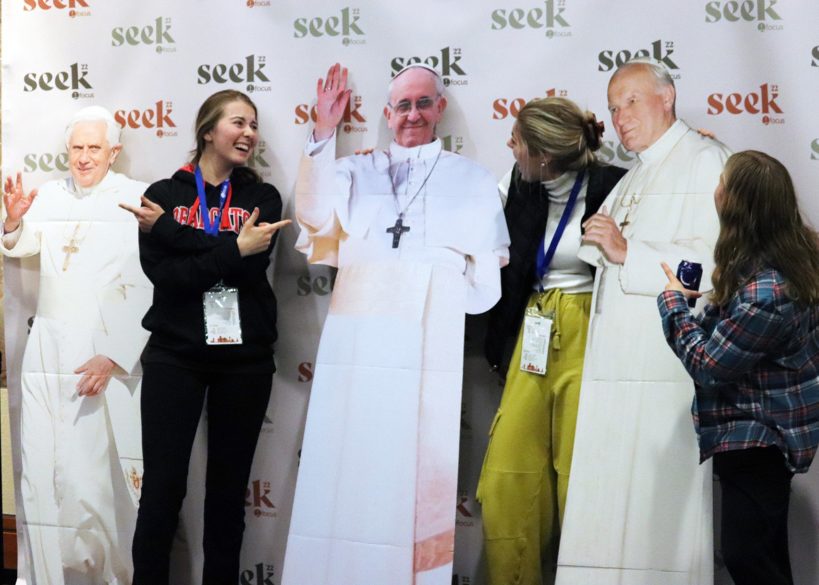
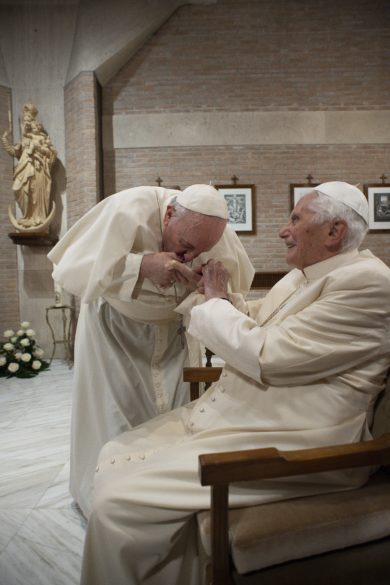
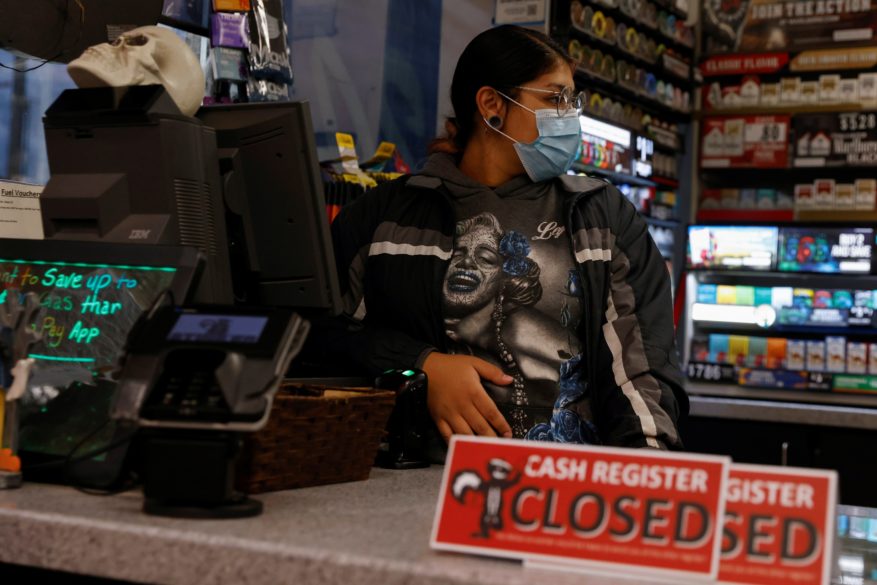
NATION
WASHINGTON (CNS) – Prominent leaders of the religious freedom movement introduced an organization they say will work to defend religious liberty and support political candidates at all levels of government who back the free practice of religion. Charging that religious practice is increasingly threatened by legal maneuvering and public actions that seek to limit the First Amendment’s guarantee of religious rights, speakers during an online launch of the organization Jan. 18 called on Americans to join the effort. Tom Farr, president of the Religious Freedom Institute, said the new organization will be known as the National Committee for Religious Freedom. It is being established as a separate nonprofit organization under the institute. “If religious freedom is diminished and damaged in America, our beloved country will be grievously harmed, but so too will the rest of the world,” Farr said during the launch event. “Our nation has built a system of religious freedom that, while never perfect, is unparalleled in the history of mankind. It stands as a guiding light for a world sorely in need of religious freedom.” The committee’s early efforts will focus on forming chapters in all 50 states. Supporters are asked to sign a pledge committing to protect religious freedom. The pledge is on the committee website at www.thencrf.org.
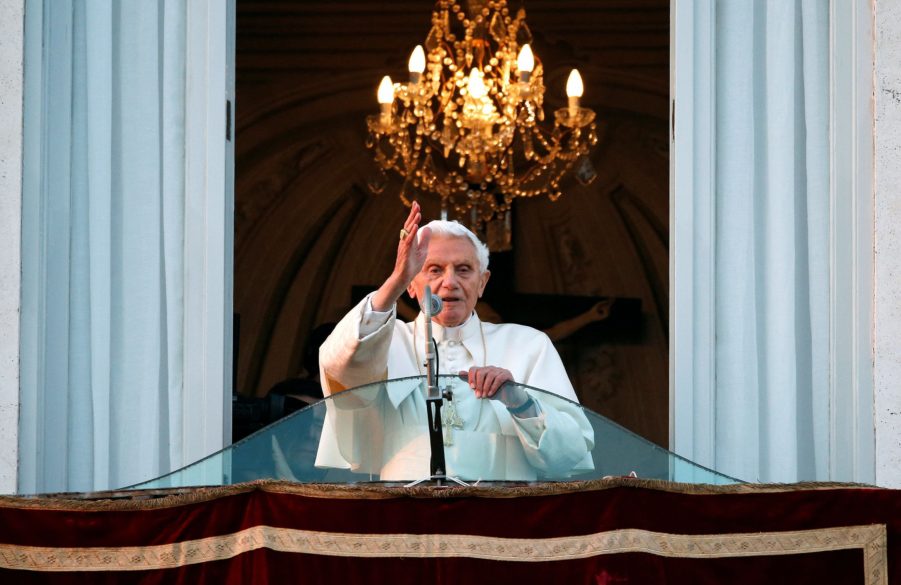
VATICAN
VATICAN CITY (CNS) – In the wake of a massive underwater volcanic eruption in Tonga, subsequent tsunamis and now contamination from volcanic ash and saltwater, Pope Francis has appealed for prayers for the people of the region. “My thoughts go to the people of the islands of Tonga, struck in recent days by the eruption of the underwater volcano, which caused enormous material damage. I am spiritually close to all the people suffering, imploring God for the relief of their suffering,” the pope said at the end of his general audience talk in the Vatican’s Paul VI audience hall Jan. 19. “I invite everyone to join me in praying for these brothers and sisters,” he said. The massive eruption Jan. 15 triggered a series of tsunamis that inundated coastal communities, destroying homes, contaminating water supplies and cutting off power and communications. Mounds of ash, which continued to fall from the volcano days after the blast, were also contaminating water sources and hampering efforts to bring in outside aid and rescue teams. However, there are concerns that bringing in aid from outside the region and distributing relief might spread the virus that causes COVID-19: Tonga recorded its first case in October. At least three people have been reported dead in the Tonga region and two in Peru from tsunamis triggered by the eruption.
WORLD
MUNICH, Germany (CNS) – A law firm’s report on how abuse cases were handled in the Archdiocese of Munich and Freising incriminated retired Pope Benedict XVI, with lawyers accusing him of misconduct in four cases during his tenure as Munich archbishop. Lawyer Martin Pusch of the law firm Westpfahl Spilker Wastl said the retired pope had denied wrongdoing in all cases, reported the German Catholic news agency KNA. Pusch expressed doubt about Pope Benedict’s claim of ignorance in some cases, saying this was, at times, “hardly reconcilable” with the files. At the Vatican, Matteo Bruni, director of the Vatican press office, said, “The Holy See believes it has an obligation to give serious attention to the document” on cases of abuse in the Archdiocese of Munich and Freising, but it has not yet had a chance to study it. “In the coming days, following its publication, the Holy See will review it and will be able to properly examine its details. Reiterating its sense of shame and remorse for the abuse of minors committed by clerics, the Holy See assures its closeness to all victims and confirms the path taken to protect the youngest, ensuring safe environments for them,” Bruni said. Retired Pope Benedict headed the Munich Archdiocese from 1977 to 1982, before being called to the Vatican to head the doctrinal congregation.
DUBLIN (CNS) – The Irish government has added a new public holiday to the national calendar to honor the country’s female patron, St. Brigid of Kildare. The fifth-century abbess – who is one of the country’s three patron saints along with St. Patrick and St. Columba – founded several monasteries of nuns. Her Feb. 1 feast day will become the new holiday; many Irish people mark that date as the traditional first day of spring. Bishop Denis Nulty of Kildare and Leighlin, where St. Brigid founded her largest monastic settlement, had backed calls for the female saint to be honored on the civil calendar. The new holiday, on which all public offices will close, will be in addition to St. Patrick’s Day, which falls on March 17 and is also a public holiday. This year, St. Patrick’s Day will have an extra holiday March 18 as a special “thank you” to front-line health care workers for their work during the COVID-19 pandemic.
NATION
OWENSBORO, Ky. (CNS) – Celebrating Mass in a 20-by-25-foot metal outbuilding on Dec. 24, 2021, for the displaced community of Resurrection Parish in Dawson Springs, the image that came to mind for Owensboro Bishop William F. Medley was “there was no room at the inn.” But parishioners did find room in a structure shared by a couple in the parish for Christmas Eve and Masses in the new year as well. “I felt the gratitude that the congregation could be together again – but that they were still stunned,” Bishop Medley told The Western Kentucky Catholic, diocesan newspaper of Owensboro, of the Christmas Eve Mass. The bishop had driven the 90 minutes to Dawson Springs from Owensboro that day, wanting to open the Christmas season with the Resurrection community. Resurrection Church was among the buildings lost to the historic tornadoes that hit western Kentucky during the night of Dec. 10, 2021. The strong winds had torn out windows and ripped off parts of the roof, exposing the interior of the little church to the elements. In the following days, parishioners Donnie and Rhonda Mills offered the use of their outbuilding, which is used primarily as an exercise room, as a substitute church for the time being. The parish gathered for Mass for the first time since the tornadoes on Sunday, Dec. 19. Their second gathering was that Christmas Eve. “Their doors have always been open to everybody,” said Deacon Mike Marsili.

WASHINGTON (CNS) – The 49th annual national March for Life – with a rally on the National Mall and march to the Supreme Court Jan. 21 – will go on as scheduled this year amid a surge in the omicron variant in the nation’s capital. Outdoor events are not affected by the District of Columbia’s vaccine mandate for indoor gatherings, but participants should expect to wear face masks. Indoor events associated with the annual march will have to comply with city COVID-19 restrictions. The national Pro-Life Summit, sponsored by Students for Life, is also scheduled to take place Jan. 22 at Washington’s Omni Shoreham Hotel. The March for Life has canceled its three-day Pro-Life Expo and is combining two planned Capitol Hill 101 panel discussions Jan. 20 into a single event. The organization is still holding its annual Rose Dinner Gala. Participants who are 12 and older attending the panel discussion or dinner will have to provide proof of receiving one COVID-19 vaccination by Jan. 15, or, if they are seeking a medical or religious exemption, they must have proof of a negative COVID-19 test within 24 hours of the event. The Pro-Life summit is also requiring proof of COVID-19 vaccination following the city’s regulations.
VATICAN
VATICAN CITY (CNS) – At his celebration of Mass for the Sunday of the Word of God Jan. 23, Pope Francis will formally install new catechists and lectors. The Pontifical Council for Promoting New Evangelization, which coordinates the annual celebration, said the Mass celebrated by Pope Francis in St. Peter’s Basilica will include “the conferral of the ministries of lector and catechist.” Pope Francis’ formally instituted the ministry of catechist in May 2021. He often has spoken of the importance of selecting, training and supporting catechists, who are called to lead people to a deeper relationship with Jesus, prepare them to receive the sacraments and educate them in the teachings of the church. The Sunday of the Word of God, instituted by Pope Francis in 2019, is meant to encourage among all Catholics interest in knowing the sacred Scriptures and their central role in the life of the church and the Christian faith. The theme for the 2022 celebration is “Blessed are those who hear the word of God,” a verse which comes from the Gospel of St. Luke.
VATICAN CITY (CNS) – Living out and proclaiming the Gospel are inseparable aspects at the heart of an authentically Christian life and witness, Pope Francis said in his message for World Mission Sunday. “Every Christian is called to be a missionary and witness to Christ. And the church, the community of Christ’s disciples, has no other mission than that of bringing the Gospel to the entire world by bearing witness to Christ,” the pope wrote in his message for the celebration, which will be held Oct. 23. The theme chosen for the 2022 celebration is taken from the Acts of the Apostles: “You will be my witnesses.” The Vatican released the pope’s message Jan. 6. In his message, the pope reflected on three key “foundations of the life and mission of every disciple,” beginning with the call to bear witness to Christ. While all who are baptized are called to evangelize, the pope said the mission is carried out in communion with the church and not on “one’s own initiative.”
WORLD
YANGON, Myanmar (CNS) – For Christians in Chin and Kayah states, there were no Christmas and New Year celebrations due to fighting. They have borne the brunt of a decades-old civil war and faced oppression and persecution at the hands of the military, reported ucanews.com. On Dec. 29, Catholics in Kayah’s Hpruso Township held a funeral for 35 civilians – all Catholic – killed by troops and their bodies set on fire Christmas Eve in Mo So village. Ucanews.com reported local sources said the funeral was led by catechists, because the military would not allow a local priest to officiate. The killings shocked the world and drew swift condemnation from Cardinal Charles Bo, who called it a “heartbreaking and horrific atrocity. The fact that the bodies of those killed, burned and mutilated were found on Christmas Day makes this appalling tragedy even more poignant and sickening. As much of the world celebrated the birth of our Lord Jesus Christ, the people of Mo So village suffered the terrible shock and grief of an outrageous act of inhumanity,” he said. Cardinal Bo, president of the Catholic Bishops’ Conference of Myanmar, urged the military “to stop bombing and shelling innocent people, to stop destroying homes and churches, schools and clinics” and to begin “a dialogue.”
DUBLIN (CNS) – After a year at the head of the Archdiocese of Dublin, Archbishop Dermot Farrell said, “Radical change is coming in the church,” which will see a renewal of energy and new forms of ministry. “With a powerful commitment from clergy and lay faithful, across the full range of the life and ministry of parish communities, we are going to experience a renewal of energy and the adoption of new forms of outreach and ministry,” the 67-year-old archbishop told Catholic News Service. He also said he believes change is already happening in the church’s structures all over the Western world. “Pope Francis is offering us a way of being church, the synodal pathway, of walking together more closely and being a church that is hope-filled, despite many challenges.” The leader of the largest Irish diocese, with more than 1 million Catholics and 207 parishes, invited the faithful to “walk this journey together with me – and walk it with hope: a hope that frees us to undertake radical change, a hope that inspires us to be ambitious and a hope encourages us to be brave.” In November, the archdiocese published its “Building Hope Task Force Report,” a strategic plan for pastoral renewal amid major challenges such as a collapse in revenue and priest numbers.
NAIROBI, Kenya (CNS) – As Ethiopia celebrated Christmas Jan. 7, Cardinal Berhaneyesus Souraphiel of Addis Ababa called for humility, patience and gentleness, while urging the people to remember those suffering from war. Ethiopia is celebrating the birth of Christ under the shadow of a deadly war in the northern state of Tigray. In less than 14 months, the conflict has killed thousands, displaced millions and ignited an international outcry over human rights abuses. Agencies say a huge humanitarian crisis is unfolding in the region, as food, medicine and basic needs fail to reach the people. “As we celebrate the birthday of Jesus, let us remember those who are suffering in war, those who have suffered a moral breakdown, those who have been displaced from their homes and injured, those who have lost their parents and families, by sharing in their pain and grief,” Cardinal Souraphiel said in a message. The cardinal said people needed to get away from pride, hatred and anger for the sake of peace.
By Junno Arocho Esteves
VATICAN CITY (CNS) – Adam Piekarski, a homeless man from Lódz, Poland, never imagined that the sketches he would draw in his free time while waiting for the public showers near Bernini’s Colonnade would lead to the opportunity of a lifetime.
In November, the Vatican Philatelic and Numismatic Office announced that its 2021 set of commemorative Christmas stamps would feature images of the Magi and the Holy Family painted by Piekarski.
“Art is my passion even though I never studied it,” Piekarski told Catholic News Service Dec. 1 from a quaint studio just across the street from St. Peter’s Square.

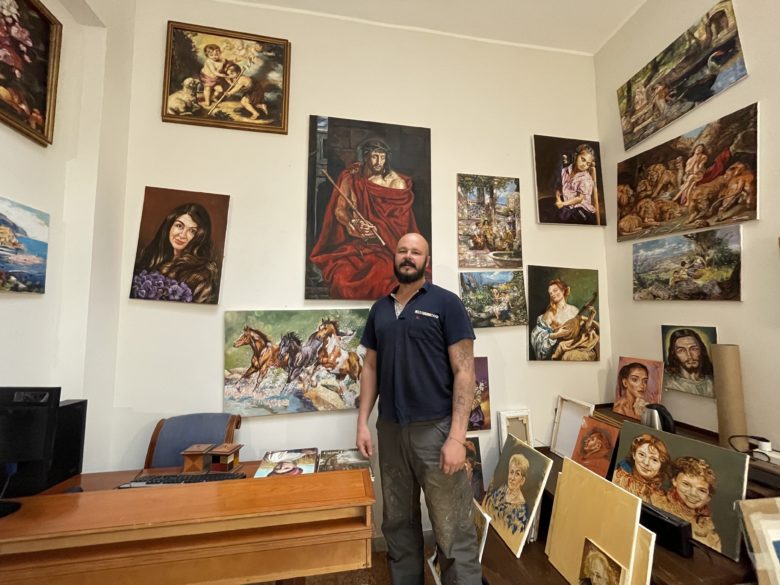
“He went to a technical school in Poland and studied gardening in Lódz,” added Redemptorist Father Leszek Pys, known by many as Father Ruben, a fellow Pole who was among the first to realize Piekarski’s talent.
Piekarski left Poland six years ago and, like many migrants, made his way to Rome seeking a better life.
However, upon his arrival, the harsh reality of finding work, coupled with a fondness for Italian wine, led Piekarski down the dark path of alcoholism that he continues to fight each day.
With Father Ruben serving as translator, Piekarski told CNS that his life began to change after meeting the Polish priest while waiting in line for the public showers for the poor at the Vatican.
Father Ruben told CNS that, at the time, he was trying to figure out a low-cost option for a painting of St. Clement Mary Hofbauer, co-founder of the Redemptorist congregation, to commemorate the 200th anniversary of his death.
Explaining his dilemma to Pallottine Sister Anna, a nun who volunteers helping the poor at the public showers, he was introduced to Piekarski, who would often spend his time sketching while waiting for his turn at the showers.
Father Ruben then provided Piekarski with paints, brushes and found a workspace in the crypt of the Church of Santa Maria in Monterone, where the burgeoning artist honed his artistic abilities.
His work drew the attention of Cardinal Konrad Krajewski, papal almoner, who then introduced Piekarski to Father Francesco Mazzitelli, then-deputy director of the Vatican Philatelic and Numismatic Office.
Father Ruben told CNS that when asked by Father Mazzitelli to design the 2021 Christmas stamps, Piekarski’s answer was an emphatic “no.” However, the Italian priest’s persistence finally moved the Polish artist to finally do it.
For the painting of the three Magi, Piekarski based their likeness on two friends who are also homeless; the third, he explained, was an original image meant to represent all homeless men and women.
Father Ruben noted that installing showers for the homeless at the Vatican was more than just an act of charity for the poor during the 2015 Jubilee Year of Mercy, but a fundamental gesture that gave homeless men and women dignity.
“You can’t give back someone’s dignity by giving them a sandwich or a euro nor even by asking them their name. That is more of a philanthropic gesture that makes us feel good about ourselves,” the Polish priest said.
“But for that person, that sandwich, that euro doesn’t change anything,” he added. “But allowing them to clean themselves means giving them back their dignity.”
While he continues to paint from a small studio at Palazzo Migliori, the Vatican’s homeless shelter, Piekarski now works as an evening security guard at a property owned by the Knights of Malta, who became acquainted with him after he completed a portrait of the late Fra’ Giacomo dalla Torre, the grand knight of the order who died in 2020.
“Life is a mystery and God wanted it this way,” Piekarski told CNS. “What has happened is a dream and I still can’t believe it. God has a great sense of humor.”
(Follow Arocho on Twitter: @arochoju)
NATION
INDIANAPOLIS (CNS) – Jim Liston believes his idea of emphasizing the true meaning of Christmas is so simple that he wonders why it took him so long to think of it. The idea came to Liston as he traveled through the neighborhoods around his Indianapolis home and saw how many people decorated their houses with brilliant light displays and filled their lawns with large, inflated Santas, reindeer and snowmen. It suddenly hit him that he rarely saw another kind of Christmas display. “It’s almost an anomaly when you see a Nativity scene,” said Liston, a member of St. Thomas Aquinas Parish in Indianapolis. “We’re in a society where everything about Christmas is glitz and consumerism. The simplicity of the Nativity scene struck me right in the heart. This is what Christmas is all about. I thought, ‘Why don’t I get one?’” Liston not only got one – and loved it – he also had the grand idea to make central Indiana the “Outdoor Nativity Scene Capital of the United States.” He set his plan in motion this year with a two-part approach. He contacted the manufacturer that made his Nativity scene to see if he could negotiate a reduced price for a large order. He also reached out to all the Catholic schools in the Indianapolis deaneries and in nearby Hamilton County to have them ask their families who would be interested in buying a Nativity scene to display in front of their homes.
CLEVELAND (CNS) – As an author and lecturer, Father Donald B. Cozzens, a Cleveland diocesan priest and former seminary rector, shared candid insights on the priesthood, challenging the Catholic Church to confront clericalism and renew its structure. Despite criticism privately and publicly from fellow clergy, Father Cozzens maintained that it was his love of the priesthood that prompted his outspokenness for positive change. Father Cozzens, 82, died Dec. 9 of complications from pneumonia caused by COVID-19. It was Father Cozzens’ book, “The Changing Face of the Priesthood,” published in 2000, that set the course for much of his life after he stepped down as president-rector of St. Mary Seminary and Graduate School of Theology in the Diocese of Cleveland a year later to focus on teaching and writing. He spent more than 20 years tackling the issues he believed church officials needed to address including transparency in decision-making and welcoming women into a wide role in the church. Other works included “Sacred Silence: Denial and the Crisis in the Church,” “Faith That Dares to Speak,” and “Freeing Celibacy.”
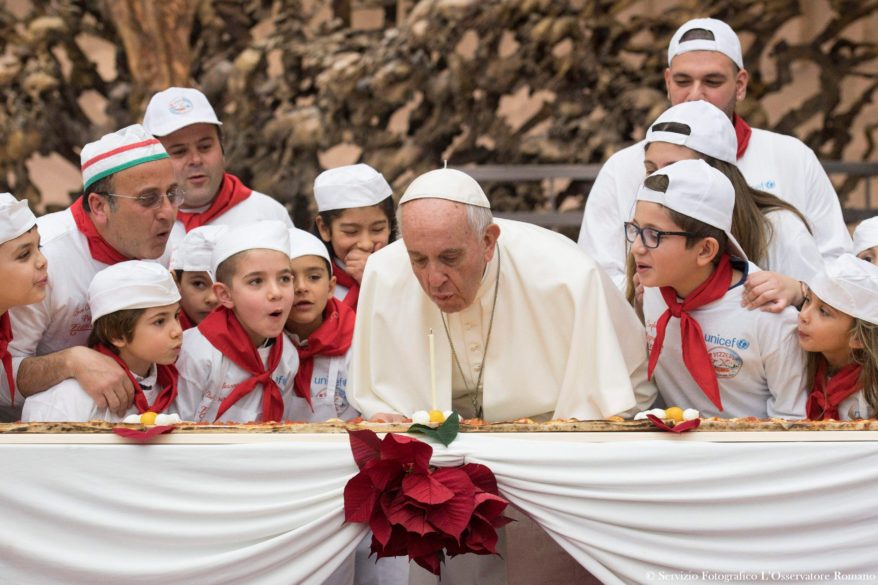
VATICAN
VATICAN CITY (CNS) – Although Italy no longer has a 10 p.m. curfew in force as part of its measures to stem the spread of COVID-19, Pope Francis will celebrate the “Christmas Mass at Night” at 7:30 p.m., as he did in 2020. On Dec. 13, the Vatican published the list of Pope Francis’ liturgies for the Christmas season. The schedule begins with what many people refer to as “midnight Mass” although the Mass has not been celebrated at midnight at the Vatican since 2009 when Pope Benedict XVI moved it to 10 p.m. Pope Francis moved it to 9:30 p.m. in 2013, his first Christmas as pope, and to 7:30 p.m. in 2020.
ROME (CNS) – Pope Francis will turn 85 years old Dec. 17. And according to his nephew, Jesuit Father José Luis Narvaja, he is still rarin’ to go. “I see him doing very well, with so much strength; really, he doesn’t seem to be 85,” the Argentine priest told the Italian Catholic magazine, Famiglia Cristiana, for its Dec. 12 issue. Father Narvaja, who is the son of the pope’s youngest sister, the late Marta Regina Bergoglio, said he visited his uncle, the pope, right after his colon surgery in July. Even then, “he was doing well but he was still in a bit of pain, and he told me, ‘Don’t make me laugh, the stitches hurt!’” he said. “He is very active, enthusiastic, he doesn’t stop. He said some people had hoped his illness would make him shut up a little, but it didn’t. He’s doing very well,” said Father Narvaja, who teaches patristics and divides his time between Rome and Cordoba, Argentina. Speaking about his uncle’s approach to his ministry as pontiff, the fellow Jesuit said, “He does what he feels the Spirit is asking of him.”
WORLD
BETHLEHEM, West Bank (CNS) – When restoration on the Church of the Nativity’s wooden beams and leaking roof began in 2013 with the blessing of the three custodial churches, everyone involved was aware of the historic significance of the venture. It was the first time in 540 years that any repair work was done on the church on the site where Jesus was born. But what the team of workers – including local Palestinian committees and engineers and international restoration experts – did not know was the true impact of the initial ecumenical cooperation. Historically the Franciscans, Greek Orthodox and Armenians jealously guarded their rights in the church, under the 1852 Status Quo agreement that regulates the ownership of spaces in various holy sites as well as the times and duration of religious liturgies. As recently as 2011, Greek Orthodox and Armenian monks came to blows over cleaning rights in a certain area in the church. But with the leaking of the roof endangering the ancient structure, all agreed to undertake the necessary work. And a new era began. “Along the way the three churches noticed the good results that were coming from the cooperation and that it would be good to continue,” said Khouloud Daibes, the new executive director of the Bethlehem Development Foundation.
SOMERSET, England (CNS) – Through the heavy oak door of a 15th-century mansion set in a sweeping, frosty valley comes the sound of singing, backed by a mix of violins, concertinas and woodwinds. “Almighty God, who hast given us thy only begotten Son to take our nature upon him – at this time born of a pure virgin.” When Thomas Clark, a cobbler, composed his Christmas Day liturgical music around 1830, he probably never expected it would still be performed two centuries later. Halsway Manor, in Somerset’s Quantock Hills, has been a center for English folk arts since the 1960s and includes “West Gallery” music by Clark and others on its annual Christmas program. “Although long neglected and forgotten, this music has an intrinsic quality,” explained Dave Townsend, co-founder of Britain’s West Gallery Music Association. “Beneath the surface simplicity of some West Gallery settings, there’s a depth of feeling not found in more expansive music from the period. It was central to people’s lives and deserves historical recognition.”
NATION
BALTIMORE (CNS) – A funeral Mass was offered Nov. 23 at St. Peter Claver Church in West Baltimore for Beverly A. Carroll, a social justice advocate who spent her life raising her voice for African American Catholics in the Archdiocese of Baltimore, the United States and the world. Carroll, the founding director of the U.S. Conference of Catholic Bishops’ Secretariat for Black Catholics, died Nov. 13. She was 75. Bishop John H. Ricard, a former auxiliary bishop of Baltimore and current superior general of the Baltimore-based Josephites, celebrated the Mass for his friend. Carroll worked for many years with Bishop Ricard, who also is the retired bishop of Pensacola-Tallahassee. “She was a great advocate for the community, for the church, for African Americans in the church,” said Josephite Father Ray P. Bomberger, pastor of St. Peter Claver Parish, to which Carroll belonged her whole life. “She was interested in the church, the people of the church, what was going on, (and) how we could do it better,” he said. Father Bomberger praised Carroll’s devotion to her church, both in her home community and around the country, as well as her interest in education and social justice. Carroll was a lifelong parishioner of St. Peter Claver, where she served as a corporator and parish council member.
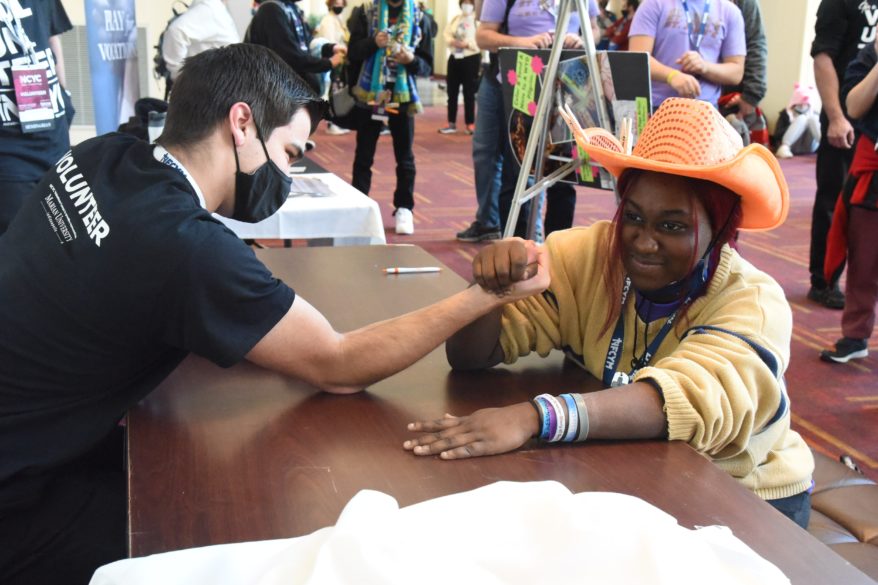
INDIANAPOLIS (CNS) – “Follow me to arm-wrestle a seminarian! See if you can beat a man who receives Communion every day!” Holding a chalk board with “Arm Wrestle a Seminarian” written on it, seminarian Samuel Hansen barked his invitation while walking through the halls of the Indiana Convention Center Nov. 20, the final day of the National Catholic Youth Conference. “It was incredibly fun,” said Hansen, a senior at Bishop Simon Bruté College Seminary and a member of St. Roch Parish, both in Indianapolis. “Just walking with the sign made a lot of people laugh. I felt like a ballpark food salesman. But it energized the convention center quite a bit.” In response to Hansen’s hawking, a steady group of challengers gathered around a table promoting vocations to the diocesan priesthood that had earlier attracted fewer visitors when the seminarians manning it waited for NCYC participants to come to them on their own. As lighthearted and winsome as his strategy to attract attention was, Hansen saw it as following in the tradition of the saints. St. John Bosco, for example, did sleight-of-hand tricks and juggling acts for kids in his village to get them to listen to his catechesis lesson. The NCYC always includes a thematic area made up of villages, or venues, in the convention hall that have traditional exhibits as well as interactive educational and recreational activities for attendees. “The saints stepped out of line and took extraordinary actions to inspire others,” Hansen told The Criterion, newspaper of the Archdiocese of Indianapolis.
VATICAN
VATICAN CITY (CNS) – Pope Francis signed a decree recognizing a miracle attributed to the intercession of Blessed Titus Brandsma, clearing the way for the canonization of the 20th-century martyr murdered at the Dachau concentration camp. The Dutch Carmelite friar was sent to Dachau for treason – after defending Jews and press freedom – and was killed with a lethal injection. The Vatican announced Pope Francis’ decision in his case and a number of other sainthood causes Nov. 25. Dachau, the notorious Nazi concentration camp in Germany most associated with the genocide of thousands of Jews during World War II, also held more than 2,700 clergy – 2,400 of them Catholic priests. Blessed Brandsma was sent there after urging editors of the Dutch Catholic press to violate a new law of the Third Reich and not print any Nazi propaganda. He also denounced Nazism as “a sewer of falsehood that must not be tolerated,” said Dianne Traflet, an assistant professor of pastoral theology and the associate dean of graduate studies at Seton Hall University in South Orange, New Jersey, during a talk at the national World War II Museum in 2018. Pope Francis also recognized a miracle attributed to the intercession of Blessed Carolina Santocanale, also known as Blessed Mary of Jesus, an Italian nun born in 1852, who founded the Congregation of the Capuchin Sisters of the Immaculate of Lourdes. The Vatican did not immediately announce dates for the canonization ceremonies.
WORLD
ANKAWA, Iraq (CNS) – Walking through this mainly Christian town outside of Irbil, the capital of Iraqi Kurdistan, it’s easy to see many changes since the victims of Islamic State militants fled here for safety seven years ago. Gone are the tents and caravans that dotted church yards and open fields to house those escaping forced conversion to Islam or death at the hands of the Islamic State militants in 2014. Colorful laundry once hung from balconies, while some people slept on church pews. The cavernous concrete skeleton of a shopping mall then sheltered 2,500 displaced people. Support from Catholic and other churches built and cordoned off rooms on three-stories; each room housed a single family, and all shared basic cooking and bathroom facilities. The unfinished structure has given way to the Ankawa Mall, where people can food shop at the French Carrefour supermarket, eat in a Turkish restaurant or buy Hello Kitty accessories at a Japanese import shop. In 2017, the Iraqi military and U.S.-led coalition troops forced out Islamic State fighters. Since then, Catholic churches and organizations have been working hard to address challenges faced by Iraq’s historic Christian community and other religious minorities. “People have faced tremendous difficulties and wounding by the Islamic State. We are still experiencing the practical effects of loss and trauma,” said Fadi, an Armenian Christian worshipping at a local church. Chaldean Catholic Archbishop Bashar Warda of Irbil stewarded the building of four schools, a university and a hospital, providing local people with badly needed employment, with assistance from Stephen Rasche, who is counsel to the Chaldean Archdiocese of Irbil.
VANCOUVER, British Columbia (CNS) – When Father Francis Galvan left Sacred Heart Church in Delta Nov. 15, he did not expect to find himself at the center of a catastrophic flood and what is being called the storm of the century. But within hours, the Augustinian priest was at ground zero of rescue efforts and witnessing humanity at its best, joining with Agassiz residents in responding to the needs of stranded travelers. “There I saw and realized how the human heart in the worst situations comes out its best – eyes looking only at those in need of help,” he told The B.C. Catholic, newspaper of the Vancouver Archdiocese, by email. Father Galvan arrived in Harrison Hot Springs only to find the study week canceled due to torrential rains, so he headed over to St. Anthony of Padua Church in Agassiz to check in with pastor Father Dennis Flores. There, the two priests saw rescue helicopters flying overhead and decided to head to the town’s community center. They found themselves in the middle of a massive rescue and relief effort. “Strong winds were blowing along with heavy rains, and I watched rescue helicopters landing, one after another,” Father Galvan said. Evacuees who had been stranded by highway mudslides emerged from the helicopters.
By Cindy Wooden
VATICAN CITY (CNS) – Despite the disappointing outcome of the COP26 summit on climate change, Pope Francis said he knows it is not too late for humanity to act to combat environment destruction and increasing poverty.
The ecological crisis, the social crisis of poverty and exclusion and the health care crisis provoked by the COVID-19 pandemic are calling out “for us to change gear, to change bad habits in order to be able to dream, co-create, and act together to realize just and equitable futures,” the pope wrote in the preface to the “Laudato Si’ Reader.”
The book, available in print and as a free e-book from the Dicastery for Promoting Integral Human Development, includes the preface from Pope Francis, a message from António Guterres, secretary-general of the United Nations, and reflections by dozens of people involved in Catholic environmental, peace or charitable agencies, ambassadors, scientists, academics, young people, farmers and Indigenous people.
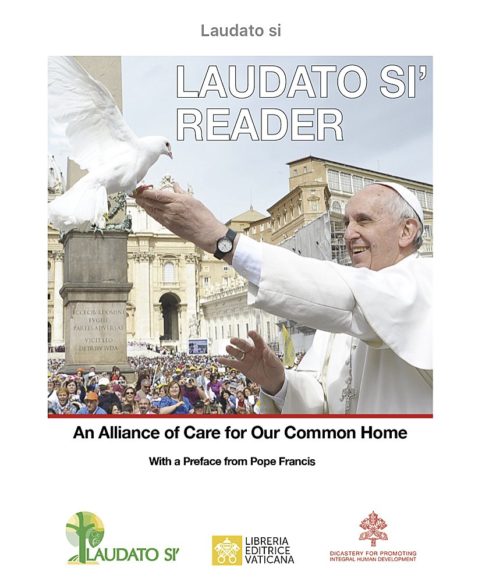
The reader, published Nov. 23, comes just over six years after the publication of Pope Francis’ encyclical, “Laudato Si’, on Care for Our Common Home.”
In his preface, Pope Francis wrote that the pandemic makes it clearer than ever that “it is time to develop a new form of universal solidarity that is grounded in fraternity, love and mutual understanding: one that values people over profit, one that seeks new ways to understand development and progress. And so, it is my hope and prayer that we do not come out of this crisis the same way we entered it!”
With so many young people so committed to fighting climate change and advocating for a more human way of organizing social and economic life, he said, “we must listen to them with open hearts. We must follow their lead, for they are wise beyond their years.”
“This is a moment to dream big, to rethink our priorities – what we value, what we want, what we seek – and re-plan our future, committing to act in our daily life on what we have dreamed of,” the pope wrote. “The time to act, and to act together, is now!”
In his message, Guterres wrote that people tend to overlook “the spiritual dimensions of the work of the United Nations,” but the values that it promotes – “peace, justice, equality, the dignity and worth of the human person – echo the teachings of the world’s religious traditions and summon us all to reduce human suffering.”
The message of Pope Francis’ encyclical is even more compelling today, he said. “Climate change has accelerated, giving the world a new normal of fires, floods and storms of epic proportions. The COVID-19 pandemic has been a grievous blow, upending lives, damaging economies and plunging families and communities into suffering and sorrow.”
“Humanity is waging war on nature,” he said, but “nature always strikes back – and is doing so with gathering fury and force.”
“Making peace with nature must be a priority for the 21st century,” Guterres wrote, and while that is an “epic policy test,” it is even more “a moral test.”
“This is a moment of truth,” he said. “If we persist with the old ways of inequality, injustice, hatred and heedless dominion over the Earth, we face disaster.”